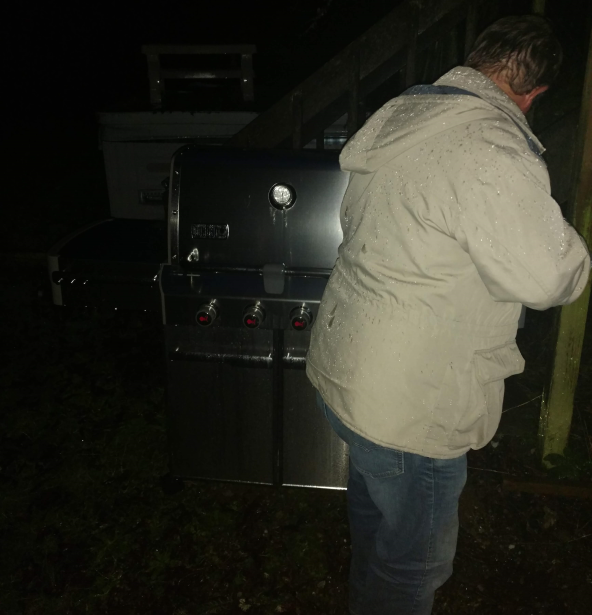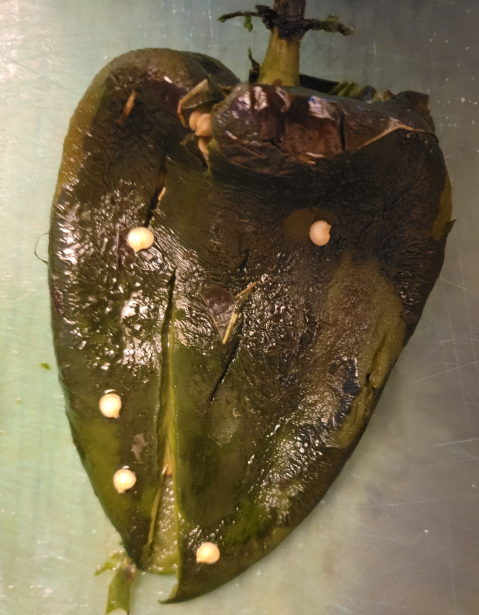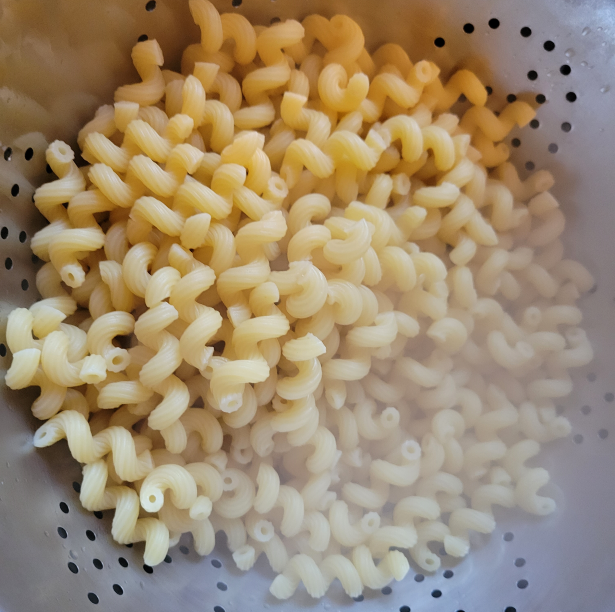KC 294 – “Rajas” Mac and Cheese

Why hello there, and welcome to Kitchen Catastrophe, where we’re busting out some Chicano comida in honor of Dia De Los Muertos. Does this have anything to do with the holiday? NO. Is it vaguely offensive to associate it with today (editors’ note: Yesterday) just because it comes from kind-of the same culture? PROBABLY. DID I COMMIT TO THIS RECIPE WITHOUT THINKING ABOUT ALL OF THAT? YES!! So if you want to skip the next thousand words kowtowing for forgiveness and get to the business, click this link. For everyone else, let’s dig in.
I’m So, So Sorry.
I’m so sorry to have inaccurately summarized the traditions of the proud and diverse populations that make up our Hispanic communities, and…Are they gone? You know who: the people who ACTUALLY THINK someone’s going to try and cancel me over cooking Mexican-American fusion, and choosing to put the POST on Día de Los Muertos. You and I, we know better, right? Good. Because, sure, it’s certainly reductive, there’s nothing WRONG with using a dish of this background as a Día De Los Muertos tie-in. A little over 25% of Hispanic adults in the US celebrated the holiday in 2012, and that was YEARS before Coco came out, so presumably that number has really jumped up.
Yes, I’m sure MANY Hispanic communities increase their religious observations because of Pixar movies.
Look, if you find the idea of me appropriating your holiday offensive, I apologize. I assure you, my intent is, in NO way, to minimize the traditions of the day…well, okay, hold on, let me get ONE point of something like minimization out of the way: and that’s a cultural phenomenon that I referenced MULTIPLE times last week, because I legitimately find it both kind of hilarious, and kind of fascinating/terrifying. It’s THIS scene:
Welcome back you crazy couple, you.
That is the OPENING of 2015’s “Spectre”, which, and you have no idea why I’m bringing this up, it’s entirely personal, but like, only 8 minutes shorter than Dune. There is PLENTY of movie space available before we should really start whining about length. Anywho, the point is that Spectre opens with 15 minutes of Bond faffing about during Mexico City’s Day of the Dead parade, destroying like, 3 city blocks, before taking a ring and never returning to the city.
What I find fascinating/amazing about it is the proud history of Mexico City’s Day of the Dead Parade: created in 2016 after Mexico City said “shit, what if a bunch of people come to see the made-up parade in that movie, and they get pissed off and it hurts our tourism”, the event continued for a proud…4 years, before COVID shut that shit down. That’s it. The movie MADE UP an event, and the city went with it, and it was kind of catching on before COVID. I bring it up to highlight that these traditions can change. 46% of those who celebrate the holiday in America say they do so in part because of the food of it. And…if it helps, you can consider this a sort of digital ofrenda of my own. I am not, to my knowledge, in anyway Hispanic. My family, culturally, however, is…Hispanic adjacent: my father grew up and worked with Hispanic people all his life. He loved ‘Mexican’ food. One of the last real pictures I have of him is of him grilling Carne Asada for tacos.
His FACE isn’t even in the damn thing. And this is the GOOD picture. The other is of his HAND.
That semi-Hispanic cuisine of Southern California reminds me of him and of his grandmother (who was ALSO not Hispanic, but who spent decades living in Oaxaca before she passed…though I’ll note in the interest of transparency that she lived there mostly for financial and aesthetic reasons: an American pension goes a lot farther near Puerto Escondido than it does near Port Orchard), which is a paradigm I’ll get into more in a couple months, but…look, Halloween has never been my favorite holiday. I like candy, and costumes, but I don’t like being scared. I don’t like images of death and predation, so I don’t watch many horror movies. I suffer silently through the extent to which it has become almost as inescapable as Christmas for the weeks preceding it, because its every gimmick and flourish is to me a prodding reminder of fear and loss, and I am a man laid low, shattered into anxiety by my inability to cope with my losses: first of my pride, autonomy, and status, and then of my father. Día de los Muertos…makes me feel better. So please. Let me process this one through a Chicano recipe. Maybe it’s not something you support, or something that would ever be on your table. But that’s fine. It’s not even really on mine: I made this recipe weeks ago, but it didn’t fit anywhere else but here. (ED: Hell, thanks to a weird quasi-migraine, it technically didn’t fit THERE either.)
Moving on To Messy Shit
That got a little more intense than I intended, but too bad. Alright, let’s get into a less fraught topic of…checking my notes…”the self-identification of minority communities in the US?” WHAT THE FUC-
Cheerful music plays over Jon’s cursing
Just in case you don’t know, “Chicano”, as in the title of the cookbook we’re cooking from, is a term of self-identification that has a robust and varied history. (Read: it’s super fucking complicated). It’s been a slur, a relatively narrow self-label, a political movement, and part of the author’s cooking blog. Chicano itself is generally considered to be an abbreviation of Mexicano, to Xicano, rendered as it sounded into “Chicano”, though the EXACT relationship is under contest. (It could for instance, be a fusion of “Chico” and “Mexicano”, or it could be derived from the Nahautl. Indeed, modern versions of the Chicano movement tend to embrace the X, which comes from the Nahautl, to emphasize the group’s embrace on how much of Mexican identity is formed and shaped by indigenous practices and beliefs.) At its simplest, the phrase is used to refer to the Mexican equivalent of Japanese nissei immigrants: second-generation members of immigrant households, themselves born in America to parents who migrated from another nation.
At a more complicated/political level…the best phrasing I have for this is that a “Chicano” is (or was) a Mexican-American who doesn’t support using the term Mexican-American because it ‘others’ Mexico from America, and because they’re pushing against an assimilationist view of their political and ethnic identity. To translate that into something more accessible to the average person: remember that, until after a couple wars, much of southwest America WAS Mexico. Like, there are families of Mexican descent who were living in California, Texas, etc before those places were “American”. And those quotes are ALSO part of the problem, since, as we’ve talked about before, it’s a tiny bit fucked up that the USA continues to call itself “American”, when, you know, there are two whole CONTINENTS of countries that have equally valid claim to the title. The “anti-assimilationist” idea is…a little fraught, but can be pretty basically explained: You know how assholes yell at people “this is America, learn to speak English”? That’s a (very basic) “assimilationist” argument: you should conform to the norms of this nation, forgoing the elements of your previous/personal culture to better fit. And there’s a constant discussion (less generously, ‘fight’) over how much assimilation one should be expected to undergo. A pointed example of this that directly connects to Chicano culture is the “Zoot Suit Riots”.
In case you’ve never seen one: this is a Zoot Suit. keep that in mind for the next segment.
More than just a moderately successful example of that weird 90’s era where we got back into swing and Big Band music, the Zoot Suit Riots were actual RIOTS, based on white residents of Los Angeles destroying “zoot suits”, a style of clothing at the time popular with ethnic minorities (particularly those of color, and Italian and Jewish youths) consisting of long, exaggerated suits born from the style of Jazz performers, and attacking those who wore them, because the extra cloth of the suit was viewed as “wasteful” and “unpatriotic” during a time of cloth rationing. Which…I mean, how do you know those suits were new? What if they just saved up their ration cards? Kinda feels like something else was behind this…which might be that zoot suits were very popular with anti-assimilationist groups, since they were an easy and obvious way to buck norms: “I have my own identity and will choose how I dress”. Imagine if there was a “Turban Riot” following 9/11 where people attacked members of the Sikh community for not wearing “normal” hats. It’s aggressive ENFORCEMENT of the norms, through the mechanism of shredded suits.
Speaking of shredded suits, let’s pry ourselves away from the fascinating and fraught history of Mexican assimilation into, and resistance to, “American” culture, and talk about the shreds we’ll be eating now. Classic O’Guin Segue.
Mix-and-Match Meal
So, this dish is predicated on combining Mac and Cheese with the Mexican dish rajas con crema. Rajas literally translates to “strips” or “rags”, and refers to a dish of strips of roasted poblano peppers, with the “con crema” variety simmered in a cream sauce (or more accurately, crema Mexicana, a dairy product that’s roughly the mid-point between whipping cream and sour cream.) often dusted with a little cheese, for a vegetarian entrée or taco filling.
And yes, it DOES look like the veggies for Fajitas. That’s what happens when you wilt peppers. They look like other wilted peppers.
Once you know that, THIS dish becomes fairly easy to deconstruct, mentally. You’ve got roasted peppers in cream sauce, and Mac-and-Cheese, which is made with béchamel, a milk/cream sauce. This is not complicated cooking. It might SEEM a little complicated, but that’s just because it has several moving parts: you gotta roast the peppers, then you gotta boil the pasta, then you gotta make the sauce…but then you literally just toss everything together and stir and you’re done.
Now, if you’ve never roasted peppers before, I want to acknowledge that it might be somewhat scary, and I want to applaud Esteban Castillo for giving me directions I can follow for the process. Because roasting peppers is one of those tasks that’s really easy or slightly irritating, depending on your stove.
If you have a gas stove, it’s literally just “turn on a burner, and cook the pepper like you’re toasting a marshmallow until it’s’ completely blackened. But I have an electric stove, so I can’t do that. Instead, I’ve got to turn on my broiler and char the peppers on a baking sheet.
It turns out I don’t have a picture of it charring, so accept this one of it just before we scrubbed the skin off.
You do this because the skin of the pepper that is charring can actually be rather easily scrubbed/rubbed off, reducing bitterness and potentially harmful chemical reactions, but it charring will impart flavor to the now-tenderized flesh remaining. But to get that skin off easily, you’ve gotta let the peppers ‘steam’ themselves: once charred, toss them in a paper bag, or a bowl covered in plastic wrap, and let them continue cooking from their own heat for 15 or so minutes.
While that’s happening, chop up some pickled jalapeños, mince some garlic, and grate some cheese. This is all of the mise-en-place, so of course I offloaded all of it to Nate.
And yes, the pickled jalapeño DOES look like the poblano. I cannot stress enough how much “small pieces of green peppers” look alike. That’s one of the reason we don’t have a ton of pictures: I TOOK more, but they all look basically the same.
We’re going to season the Cream mixture a little more intensely than you normally would for Mac and Cheese, or Rajas, depending on your definition of “normal”. These are both highly customized dishes in their respective households. Our version is using Smoked Paprika to add a little color and double up on the smoked pepper flavor, as well as the garlic, and some onion powder. We’re also adding chicken stock, which does move this out of purely vegetarian territory, but if you want to use a vegetable stock or faux-chicken flavor, that’s fine.
This is actually a pretty great dish for exploring/testing your cooking “fundamentals”: you’ve got to make a roux, and then build a sauce out of it, boil and drain pasta, chop. It’s also a recipe where you can riff really easily. We technically didn’t even follow the real recipe, because our grocery store was completely out of cavatappi pasta. We instead used cellentani…which my research says is “cavatappi with extra ridges on the outside”. Really thinking outside the box, here.
“Cellentani have ridges” was a much less popular marketing campaign than for Ruffles.
The hardest part of the process is timing: if you’re trying to get this out as quickly as possible, you’ve got to start your pasta while the peppers are steaming, and start your sauce A COUPLE MINUTES LATER. Sorry. One of the downsides of working with my family is that it’s very hard to get your mother to listen to you when you’re telling her “no, don’t start melting the butter now, we can wait five minutes”, and then having to answer “why isn’t it looking right?” with “Well, someone decided to cook out the liquid in the butter for 5 extra minutes. But assuming you can run your kitchen with an iron grip, just get your sauce sorted, slap in the peppers, then the noodles, toss, and you’ve got pasta, baby!
This doesn’t even LOOK like an abnormal Mac and Cheese. THIS is culinary assimilation, right here.
The result is perfectly fine. Our poblanos weren’t particularly spicy, so the dish is warm without veering into particularly provocative territory. It’s mildly spicy mac and cheese. Personally, I think maybe we should have left the peppers in longer strips, see if that changed up the texture, but the picture in the book seems like the peppers are pretty chopped down. It’s perfectly normal and acceptable comfort food, and something that will work great as the seasons get colder. Like I said, this isn’t traditional fare for the holiday, which I took too long to actually be officially ON, so it’s something you can bust out whenever you like. So give it a try some time!
THURSDAY: STOVES? THE ACTUAL FOOD OF THE HOLIDAY? I DON’T KNOW. I AM…WEIRDLY EXHAUSTED AND EMOTIONALLY DRAINED ATM.
MONDAY: MAYBE WE MAKE SOME SAVORY STARCHY SNACKS, MAYBE WE MAKE AN UZBEKH TRAVEL FOOD. WHO KNOWS.
And here's the
Recipe
Rajas con Mac and Cheese
Serves 4-5
Ingredients
2 Poblano peppers
Pasta
8 ounces cavatappi pasta
Salt
Water
Sauce
2 tbsp unsalted butter
3 tbsp all-purpose flour
¾ cup whole milk
¼ heavy cream
1 cup chicken stock
4 cloves of garlic, minced
1 tsp onion powder
½ tsp smoked paprika
1 cup grated Mozzarella cheese
1 cup grated Colby Jack cheese
½ cup grated Parmesan cheese
Salt
¼ cup pickled jalapeño slices, diced
Instructions
Roast the peppers: Blacken over a gas burner, or, if using an electric range, preheat your broiler to high, and roast the peppers for 5 minutes per side. Place in a paper bag and roll shut, or place in a bowl and cover with plastic wrap. Allow to steam for 15 minutes. Scrape the blackened and waxy layer of skin from the peppers, and cut into small pieces. Set aside.
Cook the pasta according to the package directions , salting the water well. Drain, and set aside.
In a large skillet (you will combine all ingredients eventually, so keep that in mind) melt the butter over medium heat. Whisk in the flour and toast for around 1 minute. Slowly whisk in the milk, cream, and stock, continuing to whisk until smooth. Add garlic, onion powder, and smoked paprika, and bring to a simmer. Cook for roughly 3 minutes, until it begins to thicken.
Remove the skillet from the heat, and add the cheese in batches, stirring to fully melt between each new batch. Season to taste with salt.
Add chopped poblano and pickled jalapeños to the sauce, and the cooked pasta, and toss to thoroughly combine everything. Spoon into bowls and serve.















